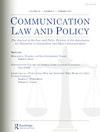摇摆不定:重新思考第一修正案保护仇恨言论的正当性
IF 0.2
Q4 LAW
引用次数: 0
摘要
在美国,仇恨言论受到宪法第一修正案的保护。这种做法与大多数其他西方民主国家不同,其中许多国家已经制定了刑事或民事法律,以惩罚那些公开煽动对种族或民族等固定身份特征的群体的仇恨的人。传统上,美国法理学和法律学术依赖于几个独立的理论来证明这种方法的合理性。这些包括思想市场、政治自治、个人自由、领头羊论、安全阀论和反向执行论。几十年来,这些理论一直被认为是美国允许仇恨言论的原因。但它们仍然站得住脚吗?社会规范正在发生变化。越来越多的美国人开始明白,压迫制度是如何塑造我们的法律和制度的。现在的年轻人比过去更愿意接受对言论自由权利的限制,以促进一个欢迎不同群体的包容性社会。鉴于这些不断变化的规范,本文提出了一个问题,即这些理论是否以及在多大程度上仍然是保护仇恨言论的可行理由。这一分析的结果是一幅关于这些思想如何在我们现代社会、政治和媒体环境中运作的全面图景。有了这种清晰的观点,我们就能更准确地权衡我们共同决定保护美国仇恨言论的潜在利弊。本文章由计算机程序翻译,如有差异,请以英文原文为准。
On Shaky Ground: Reconsidering the Justifications for First Amendment Protection of Hate Speech
Abstract In the United States, hate speech is protected by the First Amendment. This approach differs from most other Western democracies, many of which have enacted criminal or civil laws to punish those who publicly incite hatred toward groups based on their fixed identity characteristics such as race or ethnicity. Traditionally, U.S. jurisprudence and legal scholarship have relied on several discrete theories to justify this approach. These include the marketplace of ideas, political self-governance, personal liberty, the bellwether argument, the safety valve argument, and the reverse enforcement argument. For decades, these theories have been cited as the reasons why the United States allows hate speech. But do they still hold water? Social norms are changing. More Americans are beginning to understand how systems of oppression have shaped our laws and institutions. Young people are more willing now than they've been in the past to accept limits on our right to free expression to promote an inclusive society that welcomes diverse groups. Given these shifting norms, this article asks whether and to what extent each of these theories remains a viable justification for protecting hate speech. The result of this analysis is a comprehensive picture of how these ideas operate in our modern social, political, and media environments. With this clear-eyed view, we can more accurately weigh the potential benefits and drawbacks of our collective decision to protect hate speech in the United States.
求助全文
通过发布文献求助,成功后即可免费获取论文全文。
去求助
来源期刊
CiteScore
0.60
自引率
33.30%
发文量
7
期刊介绍:
The societal, cultural, economic and political dimensions of communication, including the freedoms of speech and press, are undergoing dramatic global changes. The convergence of the mass media, telecommunications, and computers has raised important questions reflected in analyses of modern communication law, policy, and regulation. Serving as a forum for discussions of these continuing and emerging questions, Communication Law and Policy considers traditional and contemporary problems of freedom of expression and dissemination, including theoretical, conceptual and methodological issues inherent in the special conditions presented by new media and information technologies.

 求助内容:
求助内容: 应助结果提醒方式:
应助结果提醒方式:


